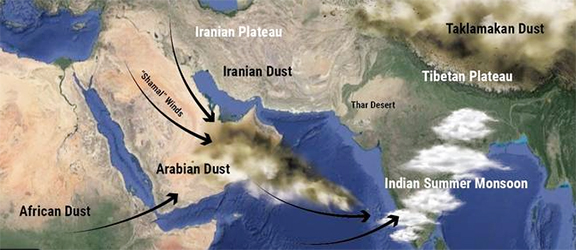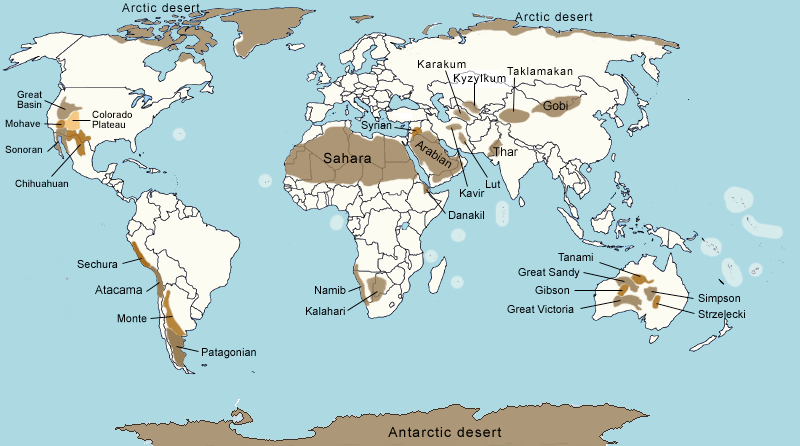Geography
Effect of Dust on Monsoon
- 05 Apr 2021
- 7 min read
Why in News
Recently, a study details how the Indian monsoon gets influenced by the atmospheric dust particles swept up by winds from deserts in the Middle East (Asian Deserts).
Key Points
- Dust :
- Dust is very small dry particles of earth or sand.
- PM10 and PM2.5 refers to dust classified by the size of particles.
- The natural erosion of soil, sand and rock is the most common source of dust.
- Dust emission is common in urban areas from a range of activities such as gardening, to large scale industrial operations.
- It is known to influence monsoons, hurricanes and even fertilize rainforests.
- The dust emission scheme is extremely sensitive to climate change and understanding these mechanisms and effects of dust can help understand our monsoon systems in the face of global climate change.
- Dust is very small dry particles of earth or sand.
- Effect of Dust on Monsoon:
- About:
- Dust storms from the desert when lifted by strong winds can absorb solar radiation and become hot.
- This can cause heating of the atmosphere, change the air pressure, wind circulation patterns, influence moisture transport and increase precipitation and rainfall.
- Effect on Indian Monsoon:
- Dust from the Middle East [West Asia] and also from the Iranian Plateau also influences the Indian Summer Monsoon (South West Monsoon).
- The hot air over the Iranian Plateau can heat the atmosphere over the plateau, strengthen the circulation over the deserts of the Arabian Peninsula and increase dust emission from the Middle East [West Asia].
- Dust from the Middle East [West Asia] and also from the Iranian Plateau also influences the Indian Summer Monsoon (South West Monsoon).
- Reverse Effect:
- Indian Summer Monsoon has a reverse effect and can increase the winds in West Asia to produce yet more dust.
- A strong monsoon can also transport air to West Asia and again pick up a lot of dust.
- About:
- Effect of Anthropogenic Dust:
- There is a difference of opinion, some studies found that anthropogenic aerosols emitted from the Indian subcontinent can decrease summer monsoon precipitation, while others found that absorbing aerosols such as dust can strengthen the monsoon circulation.
- Aerosols are defined as a combination of liquid or solid particles suspended in a gaseous or liquid environment.
- Anthropogenic aerosols include sulfate, nitrate, and carbonaceous aerosols, and are mainly from fossil fuel combustion sources.
- However, a recent study showed that they can strengthen Indian summer monsoon rainfall.
- Aerosol particles, such as dust, play an important role in the precipitation process, providing the nuclei upon which condensation and freezing take place.
- There is a difference of opinion, some studies found that anthropogenic aerosols emitted from the Indian subcontinent can decrease summer monsoon precipitation, while others found that absorbing aerosols such as dust can strengthen the monsoon circulation.
- Role of Deserts in Monsoon:
- Deserts across the globe play important roles in monsoons.
- The dust aerosols from deserts in West China such as the Taklamakan desert and the Gobi Desert can be transported eastward to eastern China and can influence the East Asia summer monsoon.
- In the southwest United States, there are some small deserts that influence the North African monsoon.
- Deserts across the globe play important roles in monsoons.
- Major Deserts of the World:
Monsoon
- About:
- A monsoon often brings about thoughts of torrential rains, similar to a hurricane or typhoon. But there is a difference: a monsoon is not a single storm; rather, it is a seasonal wind shift over a region.
- The shift may cause heavy rains in the summer, but at other times, it may cause a dry spell.
- Cause for Monsoon:
- A monsoon (from the Arabic mawsim, which means "season") arises due to a difference in temperatures between a land mass and the adjacent ocean.
- The sun warms the land and ocean differently, causing the winds to play "tug of war" eventually switching directions bringing the cooler, moister air from over the ocean.
- The winds reverse again at the end of the monsoon season.
- Types:
- Wet Monsoon:
- A wet monsoon typically occurs during the summer months (about April through September) bringing heavy rains.
- On average, approximately 75% of India's annual rainfall and about 50% of the North American monsoon region comes during the summer monsoon season.
- The wet monsoon begins when winds bring cooler, more humid air from above the oceans to the land.
- Dry Monsoon:
- A dry monsoon typically occurs between October and April.
- Instead of coming from the oceans, the winds tend to come from drier, warmer climates such as from Mongolia and northwestern China down into India.
- Dry monsoons tend to be less powerful than their summer counterparts.
- The winter monsoon occurs when "the land cools off faster than the water and a high pressure develops over the land, blocking any ocean air from penetrating." This leads to a dry period.
- Wet Monsoon:
- Location:
- A monsoon forms in the tropics (between 0 and 23.5 degrees latitude north and south) and subtropics (between 23.5 degrees and 35 degrees latitude north and south).
- The strongest monsoons tend to occur in India and South Asia in the north and Australia and Malaysia in the south.
- Monsoons also occur in southern parts of North America, in Central America, northern areas of South America, and in western Africa.








